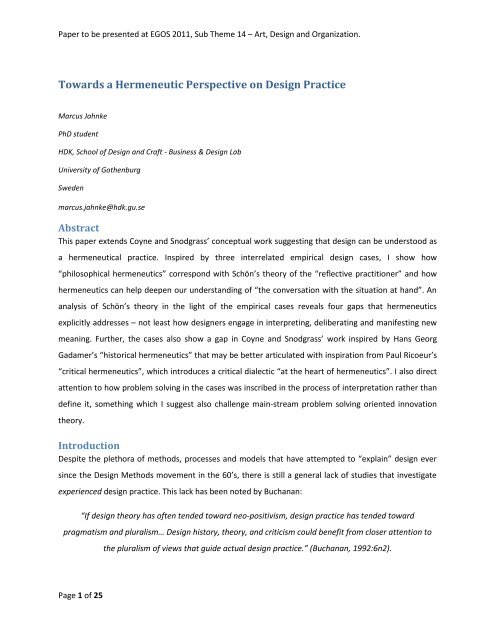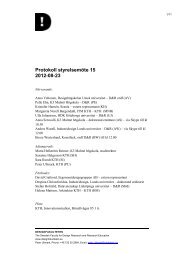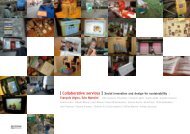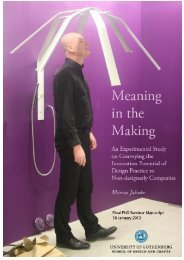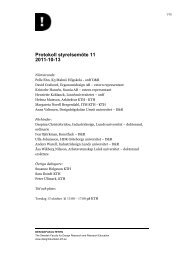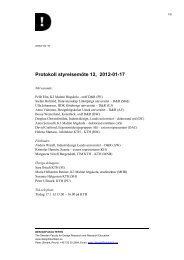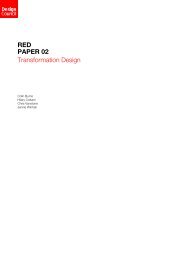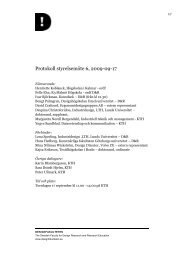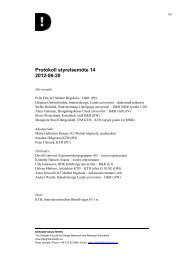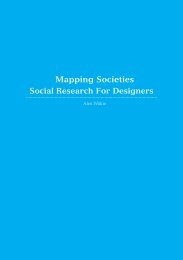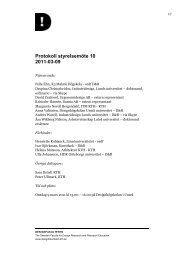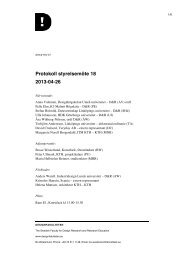Towards a Hermeneutic Perspective on Design ... - Designfakulteten
Towards a Hermeneutic Perspective on Design ... - Designfakulteten
Towards a Hermeneutic Perspective on Design ... - Designfakulteten
You also want an ePaper? Increase the reach of your titles
YUMPU automatically turns print PDFs into web optimized ePapers that Google loves.
Paper to be presented at EGOS 2011, Sub Theme 14 – Art, <strong>Design</strong> and Organizati<strong>on</strong>.<br />
<str<strong>on</strong>g>Towards</str<strong>on</strong>g> a <str<strong>on</strong>g>Hermeneutic</str<strong>on</strong>g> <str<strong>on</strong>g>Perspective</str<strong>on</strong>g> <strong>on</strong> <strong>Design</strong> Practice<br />
Marcus Jahnke<br />
PhD student<br />
HDK, School of <strong>Design</strong> and Craft - Business & <strong>Design</strong> Lab<br />
University of Gothenburg<br />
Sweden<br />
marcus.jahnke@hdk.gu.se<br />
Abstract<br />
This paper extends Coyne and Snodgrass’ c<strong>on</strong>ceptual work suggesting that design can be understood as<br />
a hermeneutical practice. Inspired by three interrelated empirical design cases, I show how<br />
“philosophical hermeneutics” corresp<strong>on</strong>d with Schön’s theory of the “reflective practiti<strong>on</strong>er” and how<br />
hermeneutics can help deepen our understanding of “the c<strong>on</strong>versati<strong>on</strong> with the situati<strong>on</strong> at hand”. An<br />
analysis of Schön’s theory in the light of the empirical cases reveals four gaps that hermeneutics<br />
explicitly addresses – not least how designers engage in interpreting, deliberating and manifesting new<br />
meaning. Further, the cases also show a gap in Coyne and Snodgrass’ work inspired by Hans Georg<br />
Gadamer’s “historical hermeneutics” that may be better articulated with inspirati<strong>on</strong> from Paul Ricoeur’s<br />
“critical hermeneutics”, which introduces a critical dialectic “at the heart of hermeneutics”. I also direct<br />
attenti<strong>on</strong> to how problem solving in the cases was inscribed in the process of interpretati<strong>on</strong> rather than<br />
define it, something which I suggest also challenge main-stream problem solving oriented innovati<strong>on</strong><br />
theory.<br />
Introducti<strong>on</strong><br />
Despite the plethora of methods, processes and models that have attempted to “explain” design ever<br />
since the <strong>Design</strong> Methods movement in the 60’s, there is still a general lack of studies that investigate<br />
experienced design practice. This lack has been noted by Buchanan:<br />
“If design theory has often tended toward neo-positivism, design practice has tended toward<br />
pragmatism and pluralism… <strong>Design</strong> history, theory, and criticism could benefit from closer attenti<strong>on</strong> to<br />
the pluralism of views that guide actual design practice.” (Buchanan, 1992:6n2).<br />
Page 1 of 25
Paper to be presented at EGOS 2011, Sub Theme 14 – Art, <strong>Design</strong> and Organizati<strong>on</strong>.<br />
More recently, and inspired by the “practice turn” in theory, Kimball (2009) and Stolterman (2008)<br />
express similar c<strong>on</strong>cerns. It could be argued that practice knowledge abounds in the design research<br />
discourse. But this knowledge is mostly entangled in other research objectives, is “hidden from view” as<br />
to a large extent tacit knowledge or is developed <strong>on</strong> the terms of epistemologies not reflecting design<br />
practice, not least positivist inspired <strong>on</strong>es (e.g. Krippendorff, 2006). This lack in theory becomes<br />
increasingly problematic when design practice is drawn into other c<strong>on</strong>texts, such as management and<br />
innovati<strong>on</strong> 1 .<br />
The design literature has typically presented representati<strong>on</strong>s that are “rule-like” and focus <strong>on</strong> decisi<strong>on</strong><br />
making and cogniti<strong>on</strong> rather than embodied knowledge (Sim<strong>on</strong>, 1996), or <strong>on</strong> linear sequential processes<br />
rather than entangled practices (e.g. Alexander, 1964, J<strong>on</strong>es, 1970). Even when the popular design<br />
thinking literature represents designing, it does so either in relati<strong>on</strong> to other practices in dichotomous<br />
ways, establishing design as something fundamentally “different” (e.g. Martin, 2004, Brown, 2009) or by<br />
relating its vocabulary to science, as in the case of the rather frequent use the c<strong>on</strong>cept of “abducti<strong>on</strong>” 2<br />
(e.g. Kolko, 2010, Martin, 2004). Even though such representati<strong>on</strong>s hold relevant insights, it is always in<br />
str<strong>on</strong>g relati<strong>on</strong> to something else and with a rather weak corresp<strong>on</strong>dence to actual design practice – in<br />
<strong>on</strong>e way or another, the experience of designing is abstracted away, is lost in translati<strong>on</strong>, and further<br />
that “The debilitating side of such models is the mystery about design that they promote.” (Coyne &<br />
Snodgrass, 1995:57).<br />
However, there is also another possibility. Inspired by D<strong>on</strong>ald Schön’s thoughts <strong>on</strong> metaphor (1993),<br />
Snodgrass and Coyne (Coyne & Snodgrass, 1995) argue that we need to become aware of how the<br />
metaphors we use often determine how we think about design. Snodgrass and Coyne further suggest<br />
that we should be inspired by Wittgenstein’s c<strong>on</strong>cept of “family resemblance” rather than let the<br />
1 A more specific reas<strong>on</strong> for this study is tied to an ambiti<strong>on</strong> to establish a firm foundati<strong>on</strong> for understanding the<br />
c<strong>on</strong>tributi<strong>on</strong> of design practice to the innovati<strong>on</strong> capabilities of “n<strong>on</strong>-designerly” companies. As such it is also a<br />
theoretical as well as empirical c<strong>on</strong>tributi<strong>on</strong> to the budding stream of “design driven innovati<strong>on</strong>” (e.g. Verganti,<br />
2008).<br />
2 Abducti<strong>on</strong> is a c<strong>on</strong>cept developed by American Pragmatist Philosopher Charles Sanders Pierce to describe a logic<br />
where something is interpreted and given new meaning in a new c<strong>on</strong>text, as an alternative or complement to<br />
inductive and deductive logic which stay in the same c<strong>on</strong>text c.f. (Danermark et al, 2003), i.e. it is valid c<strong>on</strong>cept for<br />
design, but it also delimits design to “reas<strong>on</strong>ing”, or to design thinking.<br />
Page 2 of 25
Paper to be presented at EGOS 2011, Sub Theme 14 – Art, <strong>Design</strong> and Organizati<strong>on</strong>.<br />
scientifically derived noti<strong>on</strong> of corresp<strong>on</strong>dence between a model and a presumed fixed reality guide our<br />
thought. To them metaphors as an alternative to models have a better fit and are better able to capture<br />
complex, situated and to a large extent embodied human experience, for example of designing. Their<br />
suggesti<strong>on</strong> is that the “<str<strong>on</strong>g>Hermeneutic</str<strong>on</strong>g> circle” is a better metaphor for designing than the dominant<br />
metaphor of problem solving 3 because it doesn’t “…destroy the complexity, subtlety, and uniqueness of<br />
the design situati<strong>on</strong>; or privilege or preclude aspects of the process, but rather respects their<br />
interdependence and interacti<strong>on</strong>.” (Snodgrass & Coyne, 1992:72).<br />
Another metaphor that seems to have a striking family resemblance with experienced design practice is<br />
D<strong>on</strong>ald Schön’s c<strong>on</strong>cept of the “reflective practiti<strong>on</strong>er”. As Coyne and Snodgrass note:<br />
“Even a cursory examinati<strong>on</strong> of the protocol studies of D<strong>on</strong>ald Schön indicates that the design process he<br />
describes works according to the dynamics of the hermeneutic circle, proceeding by way of a dialogic<br />
exchange with the design situati<strong>on</strong>” (Snodgrass & Coyne, 1997:22).<br />
The noti<strong>on</strong> of the reflective practiti<strong>on</strong>er indeed goes a l<strong>on</strong>g way to describe design as c<strong>on</strong>tingent,<br />
situati<strong>on</strong> oriented and reflective. As such it has also been a source of inspirati<strong>on</strong> to many design<br />
theorists (e.g. Laws<strong>on</strong>, 2006, Cross, 2006). However despite its merits it is also problematic in several<br />
respects that will be further discussed in the theoretical secti<strong>on</strong> of this paper. Most of all it fails to relate<br />
explicitly to issues of meaning – to how designers interpret, deliberate, and manifest meaning. This is<br />
where “philosophical hermeneutics” 4 might offer an alternative or complementary understanding which<br />
both goes deeper in relating to experienced design practice, but also in providing an understanding<br />
which also res<strong>on</strong>ates well with those key tenets of Schön’s theory which has found favour with the<br />
design practice community, not least the understanding of design as “… a reflective c<strong>on</strong>versati<strong>on</strong> with<br />
the situati<strong>on</strong>.” (Schön, 1983:43). In other words, philosophical hermeneutics, although so far a small<br />
stream in design research, may help us dig even deeper into the dialectic nature of this c<strong>on</strong>versati<strong>on</strong> and<br />
3 After all, the word “problem” has <strong>on</strong>ly been used in daily speech since around the 1920’s (Online Etymology<br />
Dicti<strong>on</strong>ary, http://www.etym<strong>on</strong>line.com/index.phpterm=problem). In other words, the everyday use, and thus<br />
the c<strong>on</strong>structi<strong>on</strong> or c<strong>on</strong>ceptualizati<strong>on</strong> of reality according to that word, is not more than about 70 years old.<br />
Similarly Lakoff and Johns<strong>on</strong> argues that the metaphor of problem solving is <strong>on</strong>e of the most influential metaphors<br />
of our time (Lakoff et al, 1980).<br />
4 I use the term ”philosophical hermeneutics” to indicate that I mean the more c<strong>on</strong>temporary hermeneutics of for<br />
example Hans Georg Gadamer and Paul Ricoeur rather than the older biblically oriented hermeneutics.<br />
Page 3 of 25
Paper to be presented at EGOS 2011, Sub Theme 14 – Art, <strong>Design</strong> and Organizati<strong>on</strong>.<br />
also better understand Schön’s seminal c<strong>on</strong>tributi<strong>on</strong>. In this paper I build <strong>on</strong> the works of Snodgrass and<br />
Coyne, who to my knowledge have d<strong>on</strong>e the most to advance an understanding of design through the<br />
lens of philosophical hermeneutics, although there are also other important c<strong>on</strong>tributi<strong>on</strong>s, not least by<br />
Winograd and Flores (1987).<br />
The paper has four main secti<strong>on</strong>s. First, in the theoretical secti<strong>on</strong> I begin by presenting an analysis of<br />
Schön’s c<strong>on</strong>cept of the Reflective Practiti<strong>on</strong>er that reveals four gaps in the theory (an analysis that has<br />
been inspired by three empirical cases that are introduced in the sec<strong>on</strong>d secti<strong>on</strong> as a complement to<br />
Coyne and Snodgrass’ c<strong>on</strong>ceptual discussi<strong>on</strong>.) I then introduce Hans Georg Gadamer’s “historical<br />
hermeneutics” that is the foundati<strong>on</strong> for Coyne and Snodgrass, and which seems to address all of these<br />
gaps. However the empirical cases also highlights a gap in Gadamer’s historical hermeneutics – the lack<br />
of a critical faculty “at the heart of hermeneutics” (Kristenss<strong>on</strong> Uggla, 2002). I therefore suggest that an<br />
even better fit with the experiences drawn from the empirical cases may be found by introducing Paul<br />
Ricouer’s “critical hermeneutics”. To illustrate this fit I introduce the cases in the sec<strong>on</strong>d secti<strong>on</strong> and<br />
then in the third secti<strong>on</strong> present an interpretati<strong>on</strong> that explicitly draws from Ricoeur’s critical<br />
hermeneutics. Finally, in the fourth secti<strong>on</strong> I reflect <strong>on</strong> how this new understanding of design practice<br />
may also provoke a new understanding of innovati<strong>on</strong> because the cases also reveal how problem solving<br />
seem to have a particular relati<strong>on</strong>ship to interpretati<strong>on</strong>, something which has been little discussed in<br />
innovati<strong>on</strong> theory.<br />
Theoretical secti<strong>on</strong><br />
Departing from Schön – an analysis of the “reflective practiti<strong>on</strong>er”<br />
When D<strong>on</strong>ald Schön introduced the now well-known c<strong>on</strong>cept of the “reflective practi<strong>on</strong>er” in 1983 it<br />
was a clear departure from the dominant problem-solving paradigm in research <strong>on</strong> professi<strong>on</strong>al<br />
knowledge (Schön, 1983). Not least did Schön critique Sim<strong>on</strong>’s proposal of a “Science of <strong>Design</strong>” that,<br />
despite being proposed as a soluti<strong>on</strong> to the poor performance of professi<strong>on</strong>als in dealing with social<br />
problems, built <strong>on</strong> decisi<strong>on</strong> theory and problem solving. To Schön “The situati<strong>on</strong>s of practice are not<br />
problems to be solved but problematic situati<strong>on</strong>s to engage in characterized by uncertainty, disorder and<br />
indeterminacy.” (ibid 15). Schön argued that practiti<strong>on</strong>ers deal which such situati<strong>on</strong>s through<br />
“reflecti<strong>on</strong>-in-acti<strong>on</strong>”. A well-known illustrati<strong>on</strong>s of this is Schön’s case where architect and tutor “Quist”<br />
shows first year architect student “Petra” “by doing” how to fit an elementary school building to a<br />
specific site characterized by a “screwy slope”. In “… a reflective c<strong>on</strong>versati<strong>on</strong> with the situati<strong>on</strong>.” (ibid<br />
43) Quist applies possible “disciplines” (for example a specific geometry) to attempt to order the<br />
Page 4 of 25
Paper to be presented at EGOS 2011, Sub Theme 14 – Art, <strong>Design</strong> and Organizati<strong>on</strong>.<br />
ambiguous situati<strong>on</strong>. Throughout the reflective process he listens to how the situati<strong>on</strong> “talks back” to<br />
him – what the possible c<strong>on</strong>sequences of this or that move might be. Thus he c<strong>on</strong>tinuously “reframes”<br />
the situati<strong>on</strong> in different ways, showing Petra by reflecting and sketching in tandem how to get out of<br />
the problematic situati<strong>on</strong> she was in.<br />
It would be easy to <strong>on</strong>ce again refer to Schön and to all the rich aspects of designing that the case<br />
illustrates. However, as enlightening as the case is, there are also a couple of limitati<strong>on</strong>s to this<br />
representati<strong>on</strong>. First, the theory of reflecti<strong>on</strong>-in-acti<strong>on</strong> is still too instrumental in the sense that it<br />
presuppose a for the most part negative something and in this way border <strong>on</strong> problem solving, even<br />
though Schön instead used the term problem setting to shift focus to reflecti<strong>on</strong>. Sec<strong>on</strong>d, the subjectobject<br />
duality is intact. The reflective practiti<strong>on</strong>er reflects <strong>on</strong> something by immersing in reflecti<strong>on</strong>, i.e.<br />
the subject is still positi<strong>on</strong>ed in a traditi<strong>on</strong>al distanced role in relati<strong>on</strong> to the object. Nor does Schön<br />
discuss the relati<strong>on</strong>ship between the situati<strong>on</strong> and the “world”. The situati<strong>on</strong> is equally intact and<br />
restricted, certainly complex but nevertheless “inert”. Third, the noti<strong>on</strong> of reflecti<strong>on</strong> seems to be<br />
restricted to an equally inert self. Schön discusses how Quist draws <strong>on</strong> his “repertoire”, but nothing<br />
more as far as I can see. Fourth, meaning is not explicitly discussed. Quist reas<strong>on</strong>s about practicalities in<br />
relati<strong>on</strong> to a “screwy slope”. In Quist’s mind meaning will probably be crucial (including how the<br />
students and staff will experience the building). But Schön, in his protocol studies of this first year<br />
tutorial case in architecture, does not capture meaning other than implicitly and, as Molander notes “…<br />
there is a lingering trace of objectivism in the sense that he [Schön] speaks as though there is still a<br />
fundamental world of facts, it’s just that the practiti<strong>on</strong>er can’t reach it.” 5 (Molander, 1996:158).<br />
Enter <str<strong>on</strong>g>Hermeneutic</str<strong>on</strong>g>s – Hans Georg Gadamer’s “historical hermeneutics”<br />
<str<strong>on</strong>g>Hermeneutic</str<strong>on</strong>g>s can be c<strong>on</strong>sidered a European cousin to the American Pragmatist traditi<strong>on</strong> in Philosophy<br />
that Schön was rooted in. Both offer a more “relativist” or “c<strong>on</strong>structivist” understanding of knowledge,<br />
culture, practices, social interacti<strong>on</strong>s, and so <strong>on</strong> - a clear c<strong>on</strong>trast to the dominant “objectivist” traditi<strong>on</strong><br />
in science. However hermeneutics has more explicitly dealt with issues of meaning. Indeed, the linguistic<br />
term hermeneutic goes back to ancient Greek mythology and to Hermes, the messenger between the<br />
Gods and the mortal humans. In order to be able to c<strong>on</strong>vey the will of the Gods to the humans Hermes<br />
had to both be able to understand the original message and then able to translate it so that intended<br />
meaning would be understood. (Kristenss<strong>on</strong> Uggla, 1994:175). <str<strong>on</strong>g>Hermeneutic</str<strong>on</strong>g> interpretati<strong>on</strong> builds <strong>on</strong> a<br />
5 My translati<strong>on</strong> from Swedish.<br />
Page 5 of 25
Paper to be presented at EGOS 2011, Sub Theme 14 – Art, <strong>Design</strong> and Organizati<strong>on</strong>.<br />
l<strong>on</strong>g history of “Biblical exegesis” which was developed during the first centuries AD to instruct how to<br />
correctly interpret the Bible (Todorov, 1989).<br />
More c<strong>on</strong>temporary hermeneutics draws from a rather different knowledge traditi<strong>on</strong> and not least <strong>on</strong><br />
Hans Georg Gadamer’s “historical hermeneutics” which was a clear departure from earlier attempts to<br />
reach back to byg<strong>on</strong>e history and catch “eternal” Truth through Method. Indeed, Gadamer’s magnum<br />
opus “Truth and Method” (Gadamer, 1996) expresses an explicit reacti<strong>on</strong> to such understandings.<br />
Gadamer instead argued that such noti<strong>on</strong>s are impossible as both the subject and the object are already<br />
situated in history – alas, there is no objective positi<strong>on</strong>. This view was inspired by German Philosopher<br />
Martin Heidegger’s <strong>on</strong>tological philosophy and the c<strong>on</strong>cepts of “Dasein” – of being in the world and of<br />
“Throwness” (Geworfenheit) – that to be in the world is to have to Interpret. But giving this situatedness<br />
validity c<strong>on</strong>cerning interpretati<strong>on</strong> also demands a fundamentally different take <strong>on</strong> Truth. What is truth if<br />
it is not in the original meaning of the text In Heidegger’s Philosophy the c<strong>on</strong>cept of Understanding (as<br />
a verb) is elevated to <strong>on</strong>tology, i.e. that to understand is “…the original characteristic of the being of<br />
human life itself” (ibid 250). Gadamer suggests that the <strong>on</strong>ly way to reach true meaning is thus via<br />
understanding 6 . Further, and inspired by Aristotle’s c<strong>on</strong>cept of Phr<strong>on</strong>esis, that truth is found in practice,<br />
and is thus reflected in “applicati<strong>on</strong>” (in a new versi<strong>on</strong> of an older text for example). This view is shared<br />
with the American Pragmatist traditi<strong>on</strong>. To reach such situated truth <strong>on</strong>e has to be immersed in<br />
interpretati<strong>on</strong>. Just as it means to lose touch with the play experience if you leave the game so the<br />
Ehrfahrung (Experience) that is fundamental to understanding is lost if <strong>on</strong>e is distanced from that which<br />
is to be interpreted, for example through Method - through objectivity Zugehörigheit (bel<strong>on</strong>ging), and<br />
therefore truth, is lost (Gadamer, 1996:104).<br />
Further, to Gadamer the practice of interpretati<strong>on</strong> is truly dialectic, i.e. it is a process characterized by<br />
active questi<strong>on</strong>ing and answering, the “… art of entering in dialogue with the text.” (ibid 368). It is a<br />
dialogue that moves in a circular pattern centrifugally towards understanding – the “hermeneutic<br />
circle” 7 . This is the cycle which very much resembles Schön’s “… oscillati<strong>on</strong> between the unit and the<br />
total.” (Schön, 1985:49). Gadamer further ties these noti<strong>on</strong>s of situated truth, meaning and<br />
understanding with the idea that historical texts “bear witness” of accumulated such “being in the<br />
6 “Understanding”, as a way to reach knowledge an interpretative traditi<strong>on</strong>, is often in Gadamer’s texts c<strong>on</strong>trasted<br />
with ”Explaining” as the way to reach knowledge in the Objectivist traditi<strong>on</strong>.<br />
7 A c<strong>on</strong>cept that he borrowed from Heidegger who in turn borrowed it from Nietzsche and Hegel.<br />
Page 6 of 25
Paper to be presented at EGOS 2011, Sub Theme 14 – Art, <strong>Design</strong> and Organizati<strong>on</strong>.<br />
world” of others before us. This fundamental principle Gadamer calls “Wirkungsgeschichte”, or in<br />
English “History of Effect” or “Effective History”. A c<strong>on</strong>sequence of these principles is that we are always<br />
“downstream” of effective history and are thus given access to the means necessary for true<br />
interpretati<strong>on</strong>. In a move that strengthens his oppositi<strong>on</strong> to scientific objectivity Gadamer then<br />
c<strong>on</strong>siders “prejudice”, or “preunderstanding”, if correctly applied in an open manner and tied to a<br />
c<strong>on</strong>siderable Bildung, as fundamental to understanding. He thus “gives nuance” to the understanding of<br />
prejudice in relati<strong>on</strong> to the objective traditi<strong>on</strong>’s solely negative understanding. The circular movement<br />
starts in <strong>on</strong>e’s own prejudice – which is part of <strong>on</strong>e’s own “horiz<strong>on</strong> of understanding”, which then<br />
evolves so that ideally when expanding through interpretati<strong>on</strong> <strong>on</strong>e´s own horiz<strong>on</strong> may fuse with the<br />
horiz<strong>on</strong> of that which is to be understood – Gadamer’s central noti<strong>on</strong> of the “fusing of horiz<strong>on</strong>s”.<br />
Further, Gadamer accords history and historical texts “Authority” as representatives of “Traditi<strong>on</strong>”. This<br />
str<strong>on</strong>g emphasis of History and Traditi<strong>on</strong> however pose a problem when we attempt to better<br />
understand a more “futurity oriented” design practice that also is part of the <strong>on</strong>-going creati<strong>on</strong> of new<br />
meaning.<br />
From <str<strong>on</strong>g>Hermeneutic</str<strong>on</strong>g> Circle to <str<strong>on</strong>g>Hermeneutic</str<strong>on</strong>g> Spiral – Paul Ricoeur’s “critical<br />
hermeneutics”<br />
One way out of the deadlock of Traditi<strong>on</strong> and Authority is to be found in French philosopher Paul<br />
Ricoeurs’ Critical <str<strong>on</strong>g>Hermeneutic</str<strong>on</strong>g>s. On the <strong>on</strong>e hand his philosophy builds further <strong>on</strong> Gadamer’s historical<br />
hermeneutics, but it also departs from it in several respects, not least in that it introduces a critical<br />
distancing dimensi<strong>on</strong> to interpretati<strong>on</strong> that Gadamer could not allow in his oppositi<strong>on</strong> to method, but<br />
also in how it enhances poetic redescripti<strong>on</strong>, for example through metaphorical language.<br />
To understand how Ricoeur can introduce a “critical faculty at the heart of interpretati<strong>on</strong>” (Kristenss<strong>on</strong><br />
Uggla, 2002) it is important to see that Ricoeur has a different relati<strong>on</strong>ship to <strong>on</strong>tology than Heidegger<br />
and Gadamer. While Ricoeur acknowledges interpretati<strong>on</strong> and the noti<strong>on</strong> of Dasein, he rejects<br />
Heidegger’s universalist ambiti<strong>on</strong> to let <strong>on</strong>tology determine everything. Instead he follows German<br />
Idealist philosopher Karl Jaspers in thinking about merely “<strong>on</strong>tological indicati<strong>on</strong>s” (Kristenss<strong>on</strong> Uggla,<br />
1994:238) - a resp<strong>on</strong>se to the risk that such ambiti<strong>on</strong>s towards <strong>on</strong>tological understanding may shut<br />
down further communicati<strong>on</strong>. Typical of Jasper’s and Ricoeur’s philosophies is that they instead accord<br />
primacy to <strong>on</strong>going and open communicati<strong>on</strong>. With this Jaspers-inspired positi<strong>on</strong> it is much easier for<br />
Ricoeur to re-introduce epistemology into hermeneutics and establish a “l<strong>on</strong>g detour” (ibid) to<br />
understanding that both involve an <strong>on</strong>tologically derived interpretati<strong>on</strong> as well as an epistemologically<br />
Page 7 of 25
Paper to be presented at EGOS 2011, Sub Theme 14 – Art, <strong>Design</strong> and Organizati<strong>on</strong>.<br />
derived reflecti<strong>on</strong> (that may be distanced and critical). To him these are intertwined in a “<str<strong>on</strong>g>Hermeneutic</str<strong>on</strong>g><br />
Spiral” which may open up to the “excess of meaning” of the world, rather than risk locking down<br />
meaning. This more postmodern understanding of discourse can be seen as a kind of positive <strong>on</strong>going<br />
battle of interpretati<strong>on</strong>s where care has to be taken to actually keep tensi<strong>on</strong>s and fricti<strong>on</strong>s in place as<br />
fundamental to this process of understanding.<br />
To achieve this integrati<strong>on</strong> of a critical faculty into the dialectic of hermeneutics Ricoeur finds inspirati<strong>on</strong><br />
in Critical Theorist and Sociologist Jürgen Habermas’ critique of Gadamer’s historical hermeneutics<br />
(Ricoeur, 1992) 8 . Habermas challenged Gadamer’s historical hermeneutics to reveal that which is made<br />
invisible in ideology. To him oppressi<strong>on</strong> occurs in the “sphere” of communicative acti<strong>on</strong> where language<br />
is distorted <strong>on</strong> the terms of the dominant power – for example through Traditi<strong>on</strong> and history writing. As<br />
hermeneutics stay in meaning through language it will not detect this distorti<strong>on</strong> if it cannot develop an<br />
explanatory critical perspective Habermas argued. This understanding supports Ricoeur’s introducti<strong>on</strong> of<br />
critique as fundamental to the ambiti<strong>on</strong> to keep communicati<strong>on</strong> open and enhance tensi<strong>on</strong> to be able to<br />
generate new meaning. Ricoeur thus proposes a fusi<strong>on</strong> between the critical attitude of Habermas bent<br />
<strong>on</strong> explaining and the interpretative approach of Gadamer’s aim for understanding. In order to achieve<br />
this move Ricoeur has to rearrange the understanding of hermeneutics in four interrelated ways.<br />
First of all, “distancing” can then be seen as a prerequisite for interpretati<strong>on</strong> rather than as its opposite.<br />
Indeed already the fixati<strong>on</strong> of the text is a kind of distancing from “original” meaning – already there ”…<br />
the world of the text fundamentally expands the world of the author” (ibid 150) making an infinite<br />
number of readings or interpretati<strong>on</strong>s possible in new socio-cultural c<strong>on</strong>texts. In other words distancing<br />
was in a sense already there in Gadamer’s hermeneutics. Sec<strong>on</strong>d, to overcome the devastating<br />
dichotomy between explaining and understanding hermeneutics has to move its discourse from the<br />
work to the practice, i.e. from the text to the act of writing (i.e. from the designed object to designing).<br />
Third, when instead departing from practice, it is vital to emphasize “poetic redescripti<strong>on</strong>” inside the<br />
process of hermeneutics, for example the use of metaphorical deliberati<strong>on</strong> to strengthen the potential<br />
to open the meaning of the text in relati<strong>on</strong> to what is external to it – i.e. to let the text open a “world”<br />
(or many), “in fr<strong>on</strong>t” of it (ibid 153). Four, the subject needs to be rearranged. As Ricoeur puts it: ”To<br />
understand is not to be mirrored in the text, but to be subjected or exposed to the text” (ibid 155). If the<br />
text opens up new worlds of understanding in fr<strong>on</strong>t of it, this also means that the self is opened up to<br />
8 I have translated quotes from the Swedish text to English.<br />
Page 8 of 25
Paper to be presented at EGOS 2011, Sub Theme 14 – Art, <strong>Design</strong> and Organizati<strong>on</strong>.<br />
receive a richer self (”un soi plus vaste”) by acquiring the possible worlds that interpretati<strong>on</strong> develops<br />
(ibid). To acquire thus becomes the dialectic counterpart to distancing - to acquire also means to<br />
surrender the noti<strong>on</strong> of an inert self.<br />
If Gadamer saw Throwness as an essential part of interpretati<strong>on</strong>, i.e. as a necessary part of the practice<br />
of interpretati<strong>on</strong>, we may also relate the c<strong>on</strong>cept of Throwness to the result of the practice as Ricoeur<br />
propose. The design, the poem, and suchlike is also something that is “thrown into the world” as a<br />
proposal to be interpreted and thus holds the capacity to open up new worlds. If we then combine the<br />
poetic reference, and the ability to rewrite reality, with a critical positi<strong>on</strong> we gain a subversive “couldbe”<br />
perspective (ibid 154), something that res<strong>on</strong>ates with design practice as understood by design<br />
theorist Håkan Edeholt who suggests that the innovati<strong>on</strong> potential in design is to propose how things<br />
“might be” (Edeholt, 2004). This is why I believe that Ricoeur’s critical hermeneutics and his metaphor of<br />
the hermeneutic spiral is an even richer metaphor and c<strong>on</strong>cept than Gadamer’s historical hermeneutics<br />
and circle – it integrates both a centering movement of reflecti<strong>on</strong> and a decentering movement of<br />
communicati<strong>on</strong> with others via manifested and poetically rich interpretati<strong>on</strong>s, for example designed<br />
objects.<br />
Presentati<strong>on</strong> of the Empirical Cases<br />
Background to the Empirical Cases<br />
This empirical study is introduced to help understand design practice as a process of interpretati<strong>on</strong>,<br />
deliberati<strong>on</strong> and manifestati<strong>on</strong> of new meaning by drawing <strong>on</strong> philosophical hermeneutics. The study<br />
builds <strong>on</strong> an experimental design project that explored the possible commercial innovati<strong>on</strong> potential of<br />
a gender perspective 9 <strong>on</strong> products (for details see Jahnke 2006 or Jahnke & Hans<strong>on</strong> 2010).<br />
In the experimental project seven master students in design explored and critically reflected <strong>on</strong> gender<br />
meanings through design. The student brief was to design interactive artefacts for an exhibiti<strong>on</strong> with the<br />
purpose of broadening the general public’s understanding of how designed objects are “gendered”. The<br />
9 The gender perspective of the project is based <strong>on</strong> an understanding of gender as socially and culturally<br />
c<strong>on</strong>structed. This view is inspired by Butler (1990, 1993) who sees gender as a discursive practice or ‘performance’,<br />
and argues that gender and the heterosexual positi<strong>on</strong> cannot be predefined. <strong>Design</strong>ed objects can then be seen as<br />
materialized representati<strong>on</strong>s of the performativity of gender, which makes design a tool for gendering as well as<br />
for “gender-bending”.<br />
Page 9 of 25
Paper to be presented at EGOS 2011, Sub Theme 14 – Art, <strong>Design</strong> and Organizati<strong>on</strong>.<br />
students used quite different strategies, including “bending” norms, make taken for granted norms<br />
visible by exaggerati<strong>on</strong>, and opening up for reflecti<strong>on</strong> through “Verfremdung” 10 .<br />
The result was a number of artefacts that incorporated radical meanings in relati<strong>on</strong> to established sociocultural<br />
norms and values. These meanings were c<strong>on</strong>veyed through colour, shape and style, and also<br />
through material and functi<strong>on</strong>al properties. The project c<strong>on</strong>sisted of three phases: 1) Explorati<strong>on</strong> and<br />
reflecti<strong>on</strong> – students explored the market place and gender implicati<strong>on</strong>s, both in theory and practice,<br />
through seminars and workshops; 2) Reflecti<strong>on</strong> and design – the students engaged in more pers<strong>on</strong>al<br />
reflecti<strong>on</strong>s through practice, based <strong>on</strong> issues of meaning that intrigued them; and 3) Exhibiti<strong>on</strong> design -<br />
which the students designed together. This paper draws primarily from experiences of phase two. I will<br />
use three cases from the study – the design of three chairs or sitting furniture that together make up an<br />
interesting span that is “entangled socially” as well as thematically. All the chairs represent an interest<br />
in the meanings of postures, space and behaviour, from the symbolic to the experienced and in relati<strong>on</strong><br />
to gender issues 11 . They also represent a range of different strategies used to c<strong>on</strong>vey meaning to the<br />
audience, including provocati<strong>on</strong>, ir<strong>on</strong>y, and hidden meanings.<br />
The research method was inspired by ethnography (Hammersley, 2007). Interviews of the participating<br />
students were carried out just after the project ended and covered the students’ experiences of the<br />
project, group reflecti<strong>on</strong>s and discussi<strong>on</strong>s, their individual design process, the result, exhibiti<strong>on</strong>, and in<br />
particular, their understanding of gender. In additi<strong>on</strong>, observati<strong>on</strong>s were made during student seminars<br />
and workshops, and later at the exhibiti<strong>on</strong> site. Visual analysis of the objects in the exhibiti<strong>on</strong> and<br />
photos of the objects complemented the students’ own interpretati<strong>on</strong>s and explanati<strong>on</strong>s.<br />
The Cases<br />
Duel by Ulrika Hegårdh – An experiment in the negotiating of sitting positi<strong>on</strong>s and claiming of space<br />
Hegårdh immediately decided that she would design some kind of chair. Her first idea came as a result<br />
of the discussi<strong>on</strong>s in the group about gender issues and bodily behaviour. She had noted that office<br />
chairs with their typical flat seats do not support traditi<strong>on</strong>al female cross-legged sitting. Her first idea<br />
10 Bertolt Brecht’s c<strong>on</strong>cept of making something well-known unfamiliar.<br />
11 Postures and our sitting behavior are restricted or bounded by our gender which can be explained both in terms<br />
of space and of body postures. For example, to sit is to culturally occupy a positi<strong>on</strong> - a man can claim his space<br />
since he is supposed to sit with his legs spread, stretching out while a woman should make space and is expected<br />
to cross her legs and keep her knees together (Jahnke 2006).<br />
Page 10 of 25
Paper to be presented at EGOS 2011, Sub Theme 14 – Art, <strong>Design</strong> and Organizati<strong>on</strong>.<br />
was to add a cushi<strong>on</strong> to support the thigh. However, this did not feel right; it enhanced stereotypes she<br />
felt and did not ring true to her inclusive design philosophy. Instead she discussed sitting from an<br />
equality point of view, and as a social rather than individual phenomen<strong>on</strong>. Now she felt more “at home”<br />
and she also experienced more support from the rest of the group, which c<strong>on</strong>firmed that this would be<br />
more “her”.<br />
Reflecting <strong>on</strong> sitting from this perspective, she decided to displace or even erase the issue of gender,<br />
and instead focus <strong>on</strong> people as individuals, bey<strong>on</strong>d gender norms. Gradually her challenge was<br />
formulated as an explorati<strong>on</strong> of how we sit together - how much space we claim or offer. She also began<br />
to c<strong>on</strong>ceive of the possibility of studying this process as an “experiment” which could be made possible<br />
through a piece of furniture.<br />
Her challenge now became to explore acts of interacti<strong>on</strong> and negotiati<strong>on</strong> in sitting. Initially she<br />
c<strong>on</strong>ceived of this as a fight over space, of power relati<strong>on</strong>s and struggle. The guiding metaphor for<br />
understanding the phenomena of sitting together became “sitting is a struggle”. On a meta-level she<br />
c<strong>on</strong>nected to a discussi<strong>on</strong> in the group about gender issues as a struggle for rights, space and power in<br />
society. She now drew from experiences of situati<strong>on</strong>s with a similar dynamic, and not least from her<br />
fascinati<strong>on</strong> with sitting in public spaces, such as railway stati<strong>on</strong>s and parks. She had noticed that in such<br />
envir<strong>on</strong>ments there is a c<strong>on</strong>stant demarcati<strong>on</strong> of space between people, and that it is a fluid, sensitive<br />
and bodily experienced process.<br />
Hegårdh started to c<strong>on</strong>ceive a piece of furniture for similar public situati<strong>on</strong>s that would actively provoke<br />
sitting as a struggle. While looking for practical ways to solve this, she remembered a kind of folding<br />
backrest that she had seen and experienced <strong>on</strong> a ferry in Thailand. The backrest could be flipped over to<br />
<strong>on</strong>e side to give space to individuals, or to the other side to allow for a group to sit together. Some<strong>on</strong>e<br />
had to actively decide the c<strong>on</strong>figurati<strong>on</strong> of the bench. Her idea was initially to use this functi<strong>on</strong> and<br />
enhance the need to interact with the backrest before sitting down – to be forced to decide how much<br />
space to allow or claim. However, as so<strong>on</strong> as she had devised this idea it did not fit with her ambiti<strong>on</strong> to<br />
not provoke unnecessarily. Instead, and as a reacti<strong>on</strong> to this, she chose to c<strong>on</strong>vey the need for<br />
cooperati<strong>on</strong>.<br />
On a meta-level, here was a relati<strong>on</strong> to and understanding of the process of increasing gender equality<br />
as a process of cooperati<strong>on</strong> rather than as a struggle or fight, something which was more true to her<br />
beliefs. In the sofa, this could be translated to a ‘balancing act’ of achieving equality of sitting – equality<br />
Page 11 of 25
Paper to be presented at EGOS 2011, Sub Theme 14 – Art, <strong>Design</strong> and Organizati<strong>on</strong>.<br />
in the sense of a negotiated equality rather than in the literal sense of absolutely equal space. Now the<br />
guiding metaphor was c<strong>on</strong>verted to become something like “sitting together as an act of balancing or<br />
cooperati<strong>on</strong>”.<br />
The new directi<strong>on</strong> also meant that Hegårdh’s noti<strong>on</strong> of the flippable backrest had to be revised. It was<br />
now c<strong>on</strong>verted to the idea of a backrest that would turn effortlessly, like a turnstile or like a vertical<br />
seesaw. This, she felt, would allow for acts of possible cooperati<strong>on</strong> or negotiati<strong>on</strong>. A lot of work went<br />
into the c<strong>on</strong>structi<strong>on</strong> of the backrest, both to make it inc<strong>on</strong>spicuous and at the same time str<strong>on</strong>g<br />
enough. Further, the sitting space had to be made flexible and not pre-determined in specifying a<br />
specific sitting placement. She explored how to enable this at great length through sketches and models<br />
before devising a rhomboid shape. This shape allowed for multiple ways of sitting and interacting with<br />
the backrest, without prescribing a specific or traditi<strong>on</strong>al sitting positi<strong>on</strong>.<br />
Thus, <strong>on</strong> the resulting sofa, <strong>on</strong>e pers<strong>on</strong> can take up a lot of space by claiming the whole backrest, resting<br />
<strong>on</strong> its mid-secti<strong>on</strong>. But as so<strong>on</strong> as some<strong>on</strong>e else wants to sit down <strong>on</strong> the same side, they have to start<br />
balancing the backrest together for both to sit comfortably. Or, <strong>on</strong>e pers<strong>on</strong> has to give up any rights to<br />
the backrest to the other. Many other negotiati<strong>on</strong> processes were also possible, with resulting diverse<br />
sitting positi<strong>on</strong>s. As the sofa was now completely open to different ways of sitting Hegårdh decided to<br />
make the appearance neutral and sombre, much like ordinary furniture for public spaces, so that it could<br />
blend in, and be taken seriously. This would also strengthen the “surprise effect” of the turning backrest<br />
that was important for the experiment. The idea was that the process should be sp<strong>on</strong>taneous. One<br />
would have to figure out al<strong>on</strong>e, or together with some<strong>on</strong>e else, how to negotiate this surprising piece of<br />
furniture.<br />
At the exhibiti<strong>on</strong>, Hegårdh guided several groups of visitors, mostly teenage pupils at the near-by high<br />
school. She felt that the idea of not pr<strong>on</strong>ouncing gender worked very well. However to observers this<br />
was not so clear-cut; the c<strong>on</strong>firmati<strong>on</strong> Hegårdh found shut out other possible interpretati<strong>on</strong>s of what<br />
went <strong>on</strong>. Hegårdh saw cooperati<strong>on</strong>; we as researchers saw both cooperati<strong>on</strong> and struggle, either as<br />
deliberate play, or as unc<strong>on</strong>scious acti<strong>on</strong>.<br />
Stiletto by Sigrid Strömgren – c<strong>on</strong>veying the sensati<strong>on</strong> of balancing <strong>on</strong> high heels through a chair<br />
Strömgren started from something associated with women and femininity – stiletto shoes. She cut out a<br />
lot of pictures of shoes from magazines during the first phase of the project. She was intrigued by how<br />
they seemed to represent a paradoxical phenomen<strong>on</strong> – both beautiful and uncomfortable at the same<br />
Page 12 of 25
Paper to be presented at EGOS 2011, Sub Theme 14 – Art, <strong>Design</strong> and Organizati<strong>on</strong>.<br />
time. While inspired by their beauty, she also reflected <strong>on</strong> how wearing such shoes restrain the freedom<br />
of movement, and that the wearer has to engage in an unnecessary and uncomfortable balancing act.<br />
On a meta-level this thought can be related to the way female attributes tend to tuck in, straighten out,<br />
and push up in order to beautify, thus often c<strong>on</strong>straining freedom of movement, especially c<strong>on</strong>sidering<br />
that products aimed at men are usually more practical and comfortable, allowing freedom of<br />
movement.<br />
Strömgren thought of different ways to “close in” <strong>on</strong> the phenomen<strong>on</strong> of stiletto shoes and decided to<br />
emulate the experience of walking in such shoes through some kind of alternative object. Other group<br />
members suggested she should make a chair resembling a shoe in leather with stitching and bows, but<br />
she did not like that idea that the chair should look like a “stylized stiletto” – that would be too<br />
simplified and stereotypical. Instead she began to think of possibilities tied to the metaphor of sitting as<br />
balancing.<br />
How the chair could c<strong>on</strong>vey an experience of “walking in high heels” was not clear-cut at the start and<br />
came to influence the c<strong>on</strong>structi<strong>on</strong>. Strömgren started out with noti<strong>on</strong> of using <strong>on</strong>ly <strong>on</strong>e leg, but since a<br />
pair of high-heels is <strong>on</strong>ly movable sideways, after much sketching and model work, the end-result<br />
became a two-legged chair with the two legs “in-line”. The two legs made it necessary to balance<br />
sideways, like when wearing stiletto shoes.<br />
The seat of the chair was also important for creating stability, and Strömgren made a couple of<br />
prototypes and tested them. For Strömgren it was important that the object functi<strong>on</strong>ed as a chair, and<br />
perhaps this ambiti<strong>on</strong> resulted in it turning out to be rather stable, perhaps too stable. At the exhibiti<strong>on</strong>,<br />
as an interactive piece of furniture, it was not immediately understood when laid down <strong>on</strong> its side, it had<br />
to be raised, tested and experienced. For some pupils visiting the exhibiti<strong>on</strong>, the balancing act was<br />
perceived as implying an imbalance between men and women – if society had been equal, the chair<br />
would have had four legs. Another reacti<strong>on</strong> was that Stiletto was surprisingly comfortable to sit <strong>on</strong>, not<br />
as unstable as might have been anticipated ,which turned out to be counterproductive to the intended<br />
meaning in the sense that some boys claimed that walking in high heeled shoes must be really easy.<br />
Slothfully 2006 by Markus Grip – an ir<strong>on</strong>ic observati<strong>on</strong> of male sitting and the male slacker<br />
Initially Grip intended to make something gender neutral. He also knew that he wanted to do a piece of<br />
furniture, and when “sitting” became a discussi<strong>on</strong> topic of interest am<strong>on</strong>g some group members, he<br />
opted for making a chair. His initial idea was inspired by the functi<strong>on</strong> of a flip-over. The chair would have<br />
Page 13 of 25
Paper to be presented at EGOS 2011, Sub Theme 14 – Art, <strong>Design</strong> and Organizati<strong>on</strong>.<br />
several seats and back rest covers with different colours and prints, and the user could choose the<br />
preferred combinati<strong>on</strong> by flipping through them, like when turning pages in a book. Further, the idea<br />
was to base the range of covers from <strong>on</strong> an investigati<strong>on</strong> of patterns and colours preferred by men and<br />
women respectively. But even though this was a quite well formulated and realizable c<strong>on</strong>cept Grip felt<br />
increasingly frustrated. Mainly, he was frustrated with the need to design a neutral chair that would<br />
remain neutral because the chair itself should not “intervene” with the acti<strong>on</strong> of choosing or with the<br />
chosen combinati<strong>on</strong> of covers.<br />
Grip struggled, then started to sketch in his 3D CAD program. He turned to his own industrial design<br />
preferences, especially to racing car design, finding that he could use these styles and expressi<strong>on</strong>s that<br />
he preferred. He started tweaking and exaggerating, and c<strong>on</strong>nected them to a stereotypical male sitting<br />
style – sitting with legs wide apart, relaxing, taking up space, hence the name “Slothfully”. Grip used the<br />
image of the male slacker as a symbol to further the understanding of stereotypical male behaviour <strong>on</strong> a<br />
meta-level, expressed in sitting as a power positi<strong>on</strong> - claiming and occupying space. The other project<br />
members supported him in changing the directi<strong>on</strong>. This surprised Grip, but they told him that the other<br />
idea never suited him, that his ability to interpret masculinity had a greater chance of succeeding.<br />
An amalgamati<strong>on</strong> of male form and male sitting emerged. The aesthetic was inspired by Hotrods and<br />
racing cars; the tubular steel “frame” resembling a “roll cage” with sharp angles, a rough surface, visible<br />
welds and flat “primer” paint. In the early design phase Grip experimented with material and form to get<br />
the expressi<strong>on</strong> right. For instance, he had never worked in metal before and as a result the welds were<br />
quite lumpy and obvious. But instead of grinding down the welds to make a smooth surface, he saw that<br />
these welds could work as a kind of functi<strong>on</strong>al decorati<strong>on</strong>. The way they were both sharp and a bit<br />
dangerous as well as “ad-hocish”, <strong>on</strong>ly helped to strengthen the expressi<strong>on</strong> of the chair – that of<br />
rawness, crudeness and masculinity.<br />
The c<strong>on</strong>cept that emerged was that of a chair which would invite you to sit down and relax, and then<br />
force you, irrespective of sex, to sit as a man. This was mediated through a groin cushi<strong>on</strong> that forced the<br />
legs apart. The c<strong>on</strong>cept was further enhanced at the exhibiti<strong>on</strong> through a photo drape with a staged<br />
photo showing a man sitting in Slothfully 2006 watching TV with a beer can in <strong>on</strong>e hand and the remote<br />
c<strong>on</strong>trol in the other. Grip used the photo as an alternative strategy to making the chair into a travesty,<br />
for example by adding beer can and remote c<strong>on</strong>trol holders.<br />
Page 14 of 25
Paper to be presented at EGOS 2011, Sub Theme 14 – Art, <strong>Design</strong> and Organizati<strong>on</strong>.<br />
At the exhibiti<strong>on</strong> many of the young guys resp<strong>on</strong>ded positively to Slothfully 2006, c<strong>on</strong>sidering it a ‘cool’<br />
and comfortable chair, and not at all provocative. This was not a surprising reacti<strong>on</strong> as sitting is a<br />
behaviour that is social c<strong>on</strong>structed and is also gendered, which was revealed when boys and girls<br />
interacted with Slothfully 2006. Girls generally expressed an opposite experience. Most of them felt<br />
uncomfortable and exposed. But some girls experienced sitting in Slothfully 2006 as very comfortable<br />
and for <strong>on</strong>e of them it was not even seen as a typical male way of sitting any l<strong>on</strong>ger. Interestingly, in<br />
terms of its aesthetic, Slothfully 2006 was not perceived as ir<strong>on</strong>ic or masculine by many of the visitors,<br />
especially not by the male high school pupils. To them it was just cool and comfortable and several boys<br />
expressed that they wanted <strong>on</strong>e. Paradoxically, some were put off by the flat red primer colour that was<br />
thought of as “girlish”; the Hotrod references were completely lost in their interpretati<strong>on</strong> and the closeto-pink<br />
t<strong>on</strong>e of the paint referred to something other than intended.<br />
Interpretati<strong>on</strong> of the Empirical Cases through the Lens of <str<strong>on</strong>g>Hermeneutic</str<strong>on</strong>g>s<br />
In this secti<strong>on</strong> I interpretate the three cases through the lens of philosophical hermeneutics. In so doing I<br />
revisit both Gadamer’s and, more specifically, Ricoueur’s main c<strong>on</strong>cepts as well as c<strong>on</strong>nect back to the<br />
gaps I found in Schön’s theory of the reflective practiti<strong>on</strong>er. At the end of the secti<strong>on</strong> I tentatively relate<br />
the findings to problem solving oriented innovati<strong>on</strong> theory.<br />
Creating within Boundaries – deliberating inevitable situatedness<br />
The students all engaged in inherently open situati<strong>on</strong>s. Through initial reflecti<strong>on</strong> and discussi<strong>on</strong> in the<br />
first phase of the project each designer established a more restricted but still rather open and complex<br />
situati<strong>on</strong>. However, it would be quite difficult to find something as c<strong>on</strong>crete as Petra’s and Quist’s<br />
“screwy slope”. An alternative understanding is to see these situati<strong>on</strong>s as inherently complex - as<br />
“assemblages” of more or less articulated meanings, material artefacts, embodied experiences, and so<br />
<strong>on</strong>. Further, these assemblages were characteristically paradoxical and all had the character of a<br />
dilemma or mystery as, for example, how gender issues and beauty were intertwined in Strömgren’s<br />
case or the ir<strong>on</strong>ic fact that Grip himself represented the privileged male positi<strong>on</strong> that he reflected <strong>on</strong><br />
and challenged. The students engaged in situati<strong>on</strong>s characterized by “excess of meaning”, to use<br />
Ricoeur’s language. Indeed, the c<strong>on</strong>cept of “wicked problems” (Rittel & Webber, 1973) could be used to<br />
describe these situati<strong>on</strong>s, but such an interpretati<strong>on</strong> neglects the fact that what was elaborated was not<br />
so much a problem but rather typical human situati<strong>on</strong>s where inspirati<strong>on</strong> can be found in almost<br />
anything, way bey<strong>on</strong>d the noti<strong>on</strong> of the problem.<br />
Page 15 of 25
Paper to be presented at EGOS 2011, Sub Theme 14 – Art, <strong>Design</strong> and Organizati<strong>on</strong>.<br />
To understand the design process in these situati<strong>on</strong>s, Claude Lévi-Strauss’ noti<strong>on</strong> of “Bricolage” may be<br />
useful (1966). Lévi-Strauss devised the bricolage metaphor to describe how mythmaking and the<br />
generati<strong>on</strong> of knowledge in “pre-scientific” cultures seems to be a “bricolage” of an already existing and<br />
more or less coherent or ruined heritage. In other words, situatedness is in no way an obstacle to finding<br />
new meaning, quite the opposite, it is a prerequisite. This res<strong>on</strong>ates exactly with how Gadamer argued<br />
that being situated in the “history of effect” cannot be avoided. The design students did not shy away<br />
from this inherently complex situati<strong>on</strong>, rather the opposite. It was not until complexity had reached a<br />
certain point, a “critical mass”, that they found it interesting to engage and start to deliberate meaning<br />
through practice. But it also took a pers<strong>on</strong>al c<strong>on</strong>necti<strong>on</strong>, a “lived experience” for interest to spark.<br />
Strömgren drew from the experience of walking in wobbly stiletto shoes, Grip from being a man (a kind<br />
of anomaly in a group where the rest of the group were women) and Hegårdh from the fascinati<strong>on</strong> with<br />
sitting in public spaces. This res<strong>on</strong>ates well with Heidegger’s “Dasein” in that there has to be something<br />
to interpret, something that demands interest, for the human being to engage at all.<br />
Drawing from Experience - working with unavoidable prejudice<br />
The above also res<strong>on</strong>ates with Gadamer’s idea that prejudice and foremeaning cannot be avoided in<br />
interpretati<strong>on</strong> - it is an inevitable c<strong>on</strong>sequence of being situated. Prejudice is tied to <strong>on</strong>e’s own horiz<strong>on</strong><br />
of understanding and it has to be c<strong>on</strong>structively engaged in interpretati<strong>on</strong> as a willingness to expand this<br />
horiz<strong>on</strong> of understanding and to open up the possibility of “fusing horiz<strong>on</strong>s” – to the understanding of<br />
something else or of the Other.<br />
In the examples we saw this dynamic clearly, especially when understanding broke down – when<br />
interest and inspirati<strong>on</strong> were lost. For example, Hegårdh’s first noti<strong>on</strong> was to design a chair that would<br />
enhance cross-legged “female” sitting. However this did not corresp<strong>on</strong>d with her own “foremeaning”, it<br />
clashed with her own views of the importance of avoiding stereotypes and her interest in the individual,<br />
regardless of gender. Therefore she left this strategy and found herself much more at home in a c<strong>on</strong>cept<br />
that would avoid traditi<strong>on</strong>al gender norms and instead focus <strong>on</strong> individuality. Similarly Grip first<br />
attempted to make a chair which would enhance unisex properties. But this did not give him any<br />
inspirati<strong>on</strong>. Instead he began to draw from his own “style preferences” that were tied to the masculinity<br />
that he wished to explore – and suddenly he was also “back <strong>on</strong> track”.<br />
This dynamic and the matter of prejudice was not really discussed in Schön’s Quist and Petra case,<br />
although the noti<strong>on</strong> “repertoire of domains” (1983:98) seems to be similar although more objectively<br />
Page 16 of 25
Paper to be presented at EGOS 2011, Sub Theme 14 – Art, <strong>Design</strong> and Organizati<strong>on</strong>.<br />
oriented. Such aspects have also been discussed, for example, by Darke as “primary generators”<br />
(Laws<strong>on</strong>, 2006:46) and Buchanan as “placements” (1992). These scholars frame this as design tools to<br />
engage when faced with a wicked problem or design challenge. Science and technology studies scholar<br />
Akrich sees the tendency of designers to depart from their own prejudices as an outright problem. She<br />
calls this “I-methodology” (implicit methodology), a problem that needs to be overcome through the use<br />
of explicit methods (1992). However to c<strong>on</strong>struct this either as a tool or as a problem, is, I believe, to<br />
play down the fundamental reas<strong>on</strong> for this phenomena – that to interpret <strong>on</strong>e have to depart from<br />
some sort of foremeanings, such as norms, values, preferences, and so <strong>on</strong>., and work with them. Such<br />
an understanding is of course no excuse for poor or normative results, which was Akrich’s c<strong>on</strong>cern, but<br />
it highlights the need to shift the idea of foremeaning into a <strong>on</strong>e that recognises that it is unavoidable<br />
and potentially c<strong>on</strong>structive.<br />
Working the In-between – understanding bey<strong>on</strong>d subject and object<br />
Al<strong>on</strong>g the way, when c<strong>on</strong>fr<strong>on</strong>ted by gender issues that were related both to society and to <strong>on</strong>e´s own<br />
beliefs and experiences, such c<strong>on</strong>fr<strong>on</strong>tati<strong>on</strong>s could be fed into the process of deliberating meaning –<br />
questi<strong>on</strong>s posed led to c<strong>on</strong>trasts that could be further investigated. This I believe is why Gadamer thinks<br />
of Bildung as important, not so much as something that you have to better understand history, but<br />
rather as something that that you live – Bildung as a process makes understanding possible. It seemed<br />
that there was a c<strong>on</strong>stantly c<strong>on</strong>trasting acti<strong>on</strong> between <strong>on</strong>e’s own horiz<strong>on</strong> being changed, the changing<br />
surrounding c<strong>on</strong>text that in particular included the student group and the evolving artefact. It was<br />
within this <strong>on</strong>going and evolving “tensi<strong>on</strong> field” that interpretati<strong>on</strong> and deliberati<strong>on</strong> of meaning through<br />
practice took place. It seems that what is then enhanced is neither the subject nor the object, but rather<br />
this intertwined situati<strong>on</strong> where the self also evolves. This is a dynamic that I believe is not apparent in<br />
Schön’s dialogue with the situati<strong>on</strong> at hand, perhaps because it is neither a l<strong>on</strong>gitudinal project nor a<br />
case explicitly rich in social meaning.<br />
In the cases there were several situati<strong>on</strong>s where students proposed an idea or a c<strong>on</strong>cept to the group,<br />
for example when Grip proposed a unisex chair or Hegårdh suggested that she would work with female<br />
sitting - and how both the resp<strong>on</strong>se from the group, as well as the designer’s own interpretati<strong>on</strong> of what<br />
he or she had “thrown forward” led to new insights – both c<strong>on</strong>necting to their existing “horiz<strong>on</strong>” of<br />
understanding but also provoking new understanding. Afterwards, in discussing this with the students<br />
they all described how the project had developed or changed how they understood the world in terms<br />
of gender issues and power relati<strong>on</strong>s etc. From this perspective designing is as much a process of<br />
Page 17 of 25
Paper to be presented at EGOS 2011, Sub Theme 14 – Art, <strong>Design</strong> and Organizati<strong>on</strong>.<br />
learning and understanding as about the resulting design. I believe that this relati<strong>on</strong>ship is also clear<br />
judging from the resulting objects. For example, in how Grip’s Slothfully 2006 holds the dilemma he is<br />
caught in and deals with, or how Hegårdh’s artifact expresses her reflecti<strong>on</strong> between two c<strong>on</strong>trasting<br />
metaphors – evidence of clearly dynamic processes of reflecti<strong>on</strong> and interpretati<strong>on</strong>. This is also exactly<br />
the communicative dimensi<strong>on</strong> that Ricoeur discusses - that keeps the work open and allows for yet<br />
other and unexpected interpretati<strong>on</strong>s. In this sense the process of <strong>on</strong>going communicati<strong>on</strong> starts<br />
already early in the design process – a more c<strong>on</strong>tinuous process of interpretati<strong>on</strong> that neither begins nor<br />
ends with the finished work or artifact – a c<strong>on</strong>stant looping within the process “from life to telling and<br />
from recepti<strong>on</strong> to life” (Kristenss<strong>on</strong> Uggla, 1994).<br />
Oscillating Between Detail and Whole – deliberating tensi<strong>on</strong>s between<br />
different levels of meaning<br />
As Coyne and Snodgrass note, what Schön frames as the “c<strong>on</strong>versati<strong>on</strong> with the situati<strong>on</strong> at hand”<br />
(1983:42) is at the core of hermeneutic interpretati<strong>on</strong>, including the oscillating movement between<br />
“details and the whole”. One interesting aspect of this in the cases was how there was an apparent<br />
oscillati<strong>on</strong> between the meaning of the emerging artefact and a more abstract level of socio-political<br />
gender issues - a kind of layering of meaning that was of course related to how the project was<br />
c<strong>on</strong>structed. When Gadamer discusses the rather solid and homogenous, c<strong>on</strong>cept “history of effect” and<br />
Traditi<strong>on</strong> we may simply regard it as a kind of more fluid “meta-c<strong>on</strong>text” of a multitude of often<br />
c<strong>on</strong>flicting, transient and inc<strong>on</strong>sistent meanings that are nevertheless always involved in all<br />
interpretati<strong>on</strong> and deliberati<strong>on</strong> of meaning. Other design scholars have also menti<strong>on</strong>ed this level of<br />
meaning, for example Cross who acknowledges that “… designers are immersed in material culture”<br />
(2006) or Verganti who has a broader view and argues that designers as interpreters engage in the<br />
“design discourse” which includes socio-cultural perspectives <strong>on</strong> design (2009).<br />
In the study of the three design cases we saw that this meta-c<strong>on</strong>text was always related to when<br />
deliberating meaning in the design process – for example in how Strömgren’s work evolved in relati<strong>on</strong> to<br />
how female attributes typically “… tuck in, straighten out and push up in order to beautify.” – in other<br />
words the typical tendency that women are restricted in society. Or how Hegårdh related her work to<br />
how identity and gender could be seen as c<strong>on</strong>trasting perspectives. Manifested meaning (in the chairs)<br />
thus developed via a negotiati<strong>on</strong> between this meta-c<strong>on</strong>text and the more material and practical level of<br />
the emerging object, that which would traditi<strong>on</strong>ally be c<strong>on</strong>sider the object of the design situati<strong>on</strong>, (e.g.<br />
the elementary school building in the Petra and Quist case). Such meaning could be understood as an<br />
Page 18 of 25
Paper to be presented at EGOS 2011, Sub Theme 14 – Art, <strong>Design</strong> and Organizati<strong>on</strong>.<br />
experienced “vertical” tensi<strong>on</strong> between these levels of meaning that may very well be c<strong>on</strong>flicting. I have<br />
chosen to call this a “register of meaning”. This register of meaning was c<strong>on</strong>tinuously deliberated in the<br />
design processes of the cases and could be seen as an expansi<strong>on</strong> of the “design domains” that Schön<br />
defined as the “… names of elements , features, relati<strong>on</strong>s and acti<strong>on</strong>s and norms used to elevate<br />
problems, c<strong>on</strong>sequences and implicati<strong>on</strong>s.” (1983:96). The expansi<strong>on</strong> made here enhance how these<br />
were not related to first of all to “evaluate” or set and solve a problematic situati<strong>on</strong>, as how meaning is<br />
engaged in Schön’s case, but to help deliberate new meaning in the emerging artefact.<br />
Another more “horiz<strong>on</strong>tal” tensi<strong>on</strong> was that between the emerging artefact and an intended user – the<br />
comm<strong>on</strong>ly referred to “empathic” dimensi<strong>on</strong> of design work. When the designers in the design cases<br />
negotiated meaning as emerging in their artefacts, they then “by default” related to what Dewey called<br />
“the perceiver” (2005), in this case to the imagined visitors to the exhibiti<strong>on</strong>. For example Grip used the<br />
strategy of ir<strong>on</strong>y by exaggerating a masculine expressi<strong>on</strong>, sensing that this would go down well with the<br />
audience c<strong>on</strong>sisting of mostly younger high school pupils. He related to this audience throughout the<br />
work, and the full aesthetic experience of sitting in the chair as well as its appearance was a direct result<br />
of this. However, to his surprise the resp<strong>on</strong>se was clearly divided in different interpretati<strong>on</strong>s. Some of<br />
the pupils immediately “got the point”, and reacted positively to the intended exaggerated meaning as<br />
an interesting provocati<strong>on</strong>, while others took Grip’s proposal of a very masculine chair literally, with the<br />
unintended result that the stereotypical norms that he tried to challenge by ir<strong>on</strong>y were instead<br />
reinforced, suggesting that to relate to the “perceiver” and manifest intended meaning does not imply<br />
“getting it right” or that the meaning is final. But it may mean that a dialogue with an intended user has<br />
taken place “in the mind” l<strong>on</strong>g before the artefact is made available to a real user, whether as a<br />
prototype or finished product.<br />
The C<strong>on</strong>stant Asking of Questi<strong>on</strong>s - the critical questi<strong>on</strong> at the heart of<br />
hermeneutics<br />
Gadamer stressed the importance of the Questi<strong>on</strong> in all interpretati<strong>on</strong>: “A questi<strong>on</strong> places what is<br />
questi<strong>on</strong>ed in a particular perspective. When a questi<strong>on</strong> arises, it breaks open the being of the object…”<br />
(ibid 362). Questi<strong>on</strong>s here are such that are borne out of “w<strong>on</strong>dering” – of an h<strong>on</strong>est wish to understand<br />
in a phenomenological sense. In the cases we may guess that were a lot of questi<strong>on</strong>s involved in the<br />
day-to-day design work but this was more difficult to observe. However, the seminars of the first phase<br />
of the project were filled with interrogative questi<strong>on</strong>s and discussi<strong>on</strong>s. Also the furniture pieces<br />
themselves may be regarded as open questi<strong>on</strong>s, as a c<strong>on</strong>trast to less c<strong>on</strong>ceptual design work. When<br />
Page 19 of 25
Paper to be presented at EGOS 2011, Sub Theme 14 – Art, <strong>Design</strong> and Organizati<strong>on</strong>.<br />
Gadamer discussed questi<strong>on</strong>s, he saw them as parts of a process of intimacy with the work where<br />
“Zugehörigheit” (bel<strong>on</strong>ging) must not be lost. Quist’s sketching may be seen as such a situati<strong>on</strong>.<br />
However, the very rais<strong>on</strong> d’être of the Gender and <strong>Design</strong> project was about revealing and deliberating<br />
gender issues that are otherwise hidden in Traditi<strong>on</strong> and Authority. This ambiti<strong>on</strong>, to visualize and<br />
subvert existing power, rings true with any Critical <strong>Design</strong> practice, or indeed with any design practice<br />
that is willing to questi<strong>on</strong> existing norms, whether political or more practical. Indeed, Critical Theory has<br />
inspired not least artistic practice (e.g. Hannula, 2003) and also c<strong>on</strong>ceptual design practice, for example<br />
Critical <strong>Design</strong> (e.g. Dunne, 2005). But, as Johanss<strong>on</strong> and Svengren argue based <strong>on</strong> empirical research,<br />
critical perspectives similar to Critical Theory seem vital to any design practice that wishes to propose<br />
soluti<strong>on</strong>s outside the existing <strong>on</strong>es (2008a:41). So there does not seem to be any c<strong>on</strong>tracti<strong>on</strong> between<br />
critique and making – quite the opposite. Judging from these cases the power of critique indeed<br />
corresp<strong>on</strong>ds with Ricoeur’s noti<strong>on</strong> that it is a fundamental dialectic “at the heart of hermeneutics”<br />
necessary for new meaning to emerge.<br />
A sensitivity to how questi<strong>on</strong>s “break open the being of the object” may also mean to be attentive to<br />
when such openings are the result of mistake - the ability to act c<strong>on</strong>structively in art <strong>on</strong> surprises or<br />
accidents, which has for example been explored by Austin and Devin (2006). Voluntary or involuntary<br />
mistakes may trigger “what goes <strong>on</strong> here” types of questi<strong>on</strong>s. In the empirical design cases several such<br />
situati<strong>on</strong>s were observed. One poignant example was when Grip was provoked by how his rough welds<br />
<strong>on</strong> the tubular frame for the chair were a clear deviati<strong>on</strong> from his slick 3D renderings. At the same time<br />
they seemed to help strengthen meaning by being sharp and provocatively “ad-hocish”, i.e. these rough<br />
welds actually enhanced the masculine expressi<strong>on</strong> he was looking for. So instead of grinding them down<br />
to make them smooth he kept them rough. This experience also helped him see that “roughness” could<br />
be achieved in other ways as well, for example through flat paint instead of glossy.<br />
Metaphorical Deliberati<strong>on</strong> - poetic redescripti<strong>on</strong> inside the process of<br />
hermeneutics<br />
As has been noted by many design scholars e.g. (e.g. Kelley, 2001, Krippendorff, 2006, Laws<strong>on</strong>, 2006,<br />
Verganti, 2009, Schön, 1979) metaphors may help the generati<strong>on</strong> of new ideas and for solving problems.<br />
I will from here <strong>on</strong> relate to an understanding derived from Ricoeur’s (1977) noti<strong>on</strong> of metaphor as<br />
assisting “speculative thought” bey<strong>on</strong>d “seeing-as” where he also understands images as part of<br />
metaphorical deliberati<strong>on</strong>, and where he c<strong>on</strong>sider metaphor as acting <strong>on</strong> a discursive level rather than<br />
<strong>on</strong> the level of the word. I also relate to Lakoff & Johns<strong>on</strong>’s (1980) noti<strong>on</strong> of “experiential metaphors” as<br />
Page 20 of 25
Paper to be presented at EGOS 2011, Sub Theme 14 – Art, <strong>Design</strong> and Organizati<strong>on</strong>.<br />
deeply c<strong>on</strong>nected with experienced practice and embodied behavior. In other words, while metaphors<br />
may help us see things in a new light they are also active in establishing new meaning that may be<br />
(partially) solidified in objects.<br />
In the empirical cases metaphorical deliberati<strong>on</strong> abound. It seemed that metaphorical deliberati<strong>on</strong> was<br />
crucial in solidifying the otherwise slippery and ambiguous situati<strong>on</strong>s. Strömgren, who wanted to c<strong>on</strong>vey<br />
the experience of walking in stiletto shoes found that she could regard sitting as balancing, as a<br />
balancing act instead of traditi<strong>on</strong>al static sitting. This was experiencing made articulate, as a kind of tool.<br />
This understanding of sitting was kept right to the end and was thus embodied in the artifact, even<br />
though as we saw, the actual sitting experience was too stable in relati<strong>on</strong> to the intended experience.<br />
In the case of Duel, Hegårdh actually devised two c<strong>on</strong>flicting metaphors of sitting together, as “struggle”<br />
and as “cooperati<strong>on</strong>”. And even though she wished to highlight cooperati<strong>on</strong> the artefact that she made<br />
seemed to embody both understandings. This also opened up a register between her two metaphors<br />
inside which the audience could experience the Duel sofa (note also that the name refers more to<br />
c<strong>on</strong>flict than cooperati<strong>on</strong>). In this sense Ulrika’s work is truly metaphoric – it opened up for interacti<strong>on</strong>,<br />
discussi<strong>on</strong> and experiencing am<strong>on</strong>g the audience as a fluid c<strong>on</strong>tinuati<strong>on</strong> of her own process of <strong>on</strong>-going<br />
interpretati<strong>on</strong>. Metaphor in this case was not “<strong>on</strong>ly” about finding a different understanding to solve a<br />
problem, as in Schön’s noti<strong>on</strong> of the “generative metaphor” (1979) – but was more in line with Ricoeur’s<br />
noti<strong>on</strong> of metaphor as a c<strong>on</strong>tinued process of open communicati<strong>on</strong> and creati<strong>on</strong> of new meaning.<br />
C<strong>on</strong>tinuous Problem Solving – innovati<strong>on</strong> inscribed in interpretati<strong>on</strong><br />
Throughout the processes practical problems were c<strong>on</strong>tinuously solved, often in ingenious ways.<br />
Furthermore, all this problem solving was completely integrated into the process of interpretati<strong>on</strong> – that<br />
is, problems were solved as needed in order for the intended meaning of the artifact to be expressed<br />
(and here I include functi<strong>on</strong> as an integrated aspect of the final expressi<strong>on</strong>).<br />
For example, Hegårdh reflected <strong>on</strong> gender related issues in relati<strong>on</strong> to design. She found that sitting in<br />
public situati<strong>on</strong>s was an interesting phenomen<strong>on</strong> and possibly c<strong>on</strong>nected to issues of struggle and<br />
cooperati<strong>on</strong> in gender equality development <strong>on</strong> a socio-cultural meta-level. The noti<strong>on</strong> that this<br />
dynamic could perhaps be manifested in a chair that is to be experienced emerged gradually, and with it<br />
also some practical problems to solve. She drew from different experiences and also managed to find a<br />
relati<strong>on</strong>ship between practice experiences of negotiating space as a kind of dynamic with another<br />
Page 21 of 25
Paper to be presented at EGOS 2011, Sub Theme 14 – Art, <strong>Design</strong> and Organizati<strong>on</strong>.<br />
experience of a clever backrest she had come across in Thailand. These noti<strong>on</strong>s were merged into the<br />
idea of a turning backrest which fitted or res<strong>on</strong>ated with the meaning she wished to manifest.<br />
Similarly Grip devised a “groin cushi<strong>on</strong>” and Strömgren came up with a two legged chair c<strong>on</strong>figurati<strong>on</strong>.<br />
Problems were solved and different functi<strong>on</strong>al soluti<strong>on</strong>s were made, but problem solving did not define<br />
the process. This experience clashes with the received understanding that innovati<strong>on</strong> is about problem<br />
solving. Interestingly this view corresp<strong>on</strong>ds with research <strong>on</strong> science within the Science and Technology<br />
Studies, that science is not as “rati<strong>on</strong>al” as it may seem (e.g. Hesse, 1980, Latour, 1993). This reversing<br />
of the relati<strong>on</strong>ship between problem solving and meaning also corresp<strong>on</strong>ds with how Innovati<strong>on</strong> scholar<br />
Roberto Verganti has proposed the c<strong>on</strong>cept of “design-driven innovati<strong>on</strong> of meaning” where the “…<br />
novelty of meaning and design language is significant and prevalent compared with novelty of<br />
functi<strong>on</strong>ality and technology.” (2008) and where technological “epiphanies” corresp<strong>on</strong>d with a process<br />
of Interpretati<strong>on</strong>. Verganti, by drawing <strong>on</strong> Krippendorff’s noti<strong>on</strong> that design is about “… making sense of<br />
things…” (1989), further argues that innovati<strong>on</strong> of meaning has been overlooked in traditi<strong>on</strong>al<br />
innovati<strong>on</strong> theory which has mostly been preoccupied with technical and functi<strong>on</strong>al innovati<strong>on</strong>. A<br />
similar argument is made by Lester and Piore (2004) who suggest that in order to better understand<br />
innovati<strong>on</strong> we need to pay closer attenti<strong>on</strong> to the “Missing Dimensi<strong>on</strong>” in innovati<strong>on</strong> – namely<br />
interpretati<strong>on</strong>. What the cases show is that a hermeneutic perspective may help lift the veil to the fact<br />
that even the sudden idea does not come out of nowhere, but from a process of interpretati<strong>on</strong> and<br />
deliberati<strong>on</strong> of meaning, including problem solving.<br />
“The real nature of the sudden idea is perhaps less that a soluti<strong>on</strong> occurs to us like an answer to a riddle<br />
than that a questi<strong>on</strong> occurs to us that breaks through into the open and thereby makes an answer<br />
Page 22 of 25<br />
possible. Every sudden idea has the structure of a questi<strong>on</strong>.” (Gadamer, 1996:366)<br />
Final Reflecti<strong>on</strong><br />
I have drawn from three empirical cases in order to c<strong>on</strong>tribute to Snodgrass and Coyne’s noti<strong>on</strong> that<br />
design may be understood as a hermeneutical practice and that the metaphor of the “hermeneutic<br />
circle” may reveal things that the dominant problem solving metaphor seems to cloud – especially<br />
things that corresp<strong>on</strong>d with the lived experience of designing. In the process I have been able to spot<br />
four gaps in Schön’s theory of the reflective practiti<strong>on</strong>er, gaps that can be addressed through the lens of<br />
philosophical hermeneutics. Here Hans Georg Gadamer’s historical hermeneutics goes a l<strong>on</strong>g way to<br />
deepening the understanding of the “c<strong>on</strong>versati<strong>on</strong> with the situati<strong>on</strong> at hand”. However it falls short of<br />
describing the observed critical distancing that seems fundamental to the ability to manifest new
Paper to be presented at EGOS 2011, Sub Theme 14 – Art, <strong>Design</strong> and Organizati<strong>on</strong>.<br />
meaning in the cases. By introducing Ricoeur’s critical hermeneutics and communicative philosophy it<br />
seems that an even better fit is achieved with its articulati<strong>on</strong> of practice rather than the work and with<br />
its more advanced metaphor of the hermeneutic spiral which keeps the tensi<strong>on</strong> alive between critique<br />
and interpretati<strong>on</strong>, distance and closeness, epistemology and <strong>on</strong>tology so that Interpretati<strong>on</strong> open the<br />
work to the world via the noti<strong>on</strong> of poetic practice at work<br />
Neither Schön’s, nor Gadamer’s or Ricoeur’s c<strong>on</strong>tributi<strong>on</strong>s should be seen as c<strong>on</strong>flicting c<strong>on</strong>cepts – quite<br />
the opposite. Together they together make up a str<strong>on</strong>g case for understanding design as a practice<br />
where new meaning as well as new ingenious practical soluti<strong>on</strong>s may emerge through a process of<br />
interpretati<strong>on</strong> and where more “rati<strong>on</strong>al” problem solving is inscribed in rather than define the process.<br />
This also seems to corresp<strong>on</strong>d with both cutting edge innovati<strong>on</strong> theory by for example Verganti and<br />
Lester and Piore, but also with established Science and Technology Studies. My hope, as an engineer,<br />
designer and design researcher, is for this budding understanding to become a str<strong>on</strong>ger stream in both<br />
design and innovati<strong>on</strong> research in the near future and for interpretati<strong>on</strong> and meaning to become more<br />
prominent perspectives also in the general discussi<strong>on</strong> about innovati<strong>on</strong> in business and society.<br />
References<br />
AKRICH, M. (1992) The De-Scripti<strong>on</strong> of Technical Objects IN BIJKER, W. L., J. (Ed.) Shaping<br />
Technology/Building Society. Studies in Sociotechnical Change, . Cambridge, MA, MIT Press.<br />
ALEXANDER, C. (1964) Notes <strong>on</strong> the Synthesis of Form, Cambridge, MA, Harvard University Press.<br />
AUSTIN, R., DEVIN, L. (2006) Accident, Intenti<strong>on</strong>, and Expectati<strong>on</strong> in Innovati<strong>on</strong>, Copenhagen Business<br />
School, Copenhagen.<br />
BROWN, T. (2009) Change by <strong>Design</strong>: How <strong>Design</strong> Thinking Transforms Organizati<strong>on</strong>s and Inspires<br />
Innovati<strong>on</strong>, New York, NY, HarperBusiness.<br />
BUCHANAN, R. (1992) Wicked problems in design thinking, <strong>Design</strong> Issues, 8, pp.5-21.<br />
COYNE, R., SNODGRASS, A. (1995). Problem setting within prevalent metaphors of design, <strong>Design</strong> Issues,<br />
Vol.11, No.2, pp.31-61.<br />
CROSS, N. (2006) <strong>Design</strong>erly Ways of Knowing, L<strong>on</strong>d<strong>on</strong>, Springer Verlag L<strong>on</strong>d<strong>on</strong> Ltd.<br />
DANERMARK, B., EKSTRÖM, M., KARLSSON, J., C., (2003) Att förklara samhället, Lund, Studentlitteratur.<br />
DEWEY, J. (2005) Art as Experience, L<strong>on</strong>d<strong>on</strong>, Penguin Books Ltd.<br />
Page 23 of 25
Paper to be presented at EGOS 2011, Sub Theme 14 – Art, <strong>Design</strong> and Organizati<strong>on</strong>.<br />
EDEHOLT, H. (2004) <strong>Design</strong>, innovati<strong>on</strong> och andra paradoxer: Om förändring satt i syste, Arkitektur.<br />
Göteborg, Chalmers University of Technology.<br />
GADAMER, H.-G. (1996) Truth and Method, L<strong>on</strong>d<strong>on</strong>, Sheed & Ward.<br />
HAMMERSLEY, M., ATKINSON, P. (2007) Ethnography: Principles in practice, New York:, Routledge.<br />
HESSE, M. (1980) Revoluti<strong>on</strong>s & Rec<strong>on</strong>structi<strong>on</strong>s in the Philosophy of Science, Bright<strong>on</strong>, The Harvester<br />
Press.<br />
JAHNKE, M. (2006) FormgivningNormgivning. IN CFK, C. F. C. S., UNIVERSITY OF GOTHENBURG (Ed.).<br />
Gothenburg.<br />
JAHNKE, M., HANSSON, L. (2010) Innovati<strong>on</strong> of meaning through design – An analysis of a gender<br />
bending design process. <strong>Design</strong> Research Journal. 2 (10).<br />
JOHANSSON, U., SVENGREN HOLM, L. (2008) Möten kring design - Om relati<strong>on</strong>er mellan design, teknik<br />
och marknadsföring, Studentlitteratur.<br />
JONES, J. C. (1970) <strong>Design</strong> Methods, Chichester, John Wiley & S<strong>on</strong>s Ltd.<br />
KIMBALL, L. (2009) <strong>Design</strong> Practices in <strong>Design</strong> Thinking. EURAM 2010. Tor Vergata University, Rome.<br />
KRIPPENDORFF, K. (1989) On the Essential C<strong>on</strong>texts of Artifacts" or <strong>on</strong> the Propositi<strong>on</strong> that "<strong>Design</strong> is<br />
Making Sense (of Things).". <strong>Design</strong> Issues, 5, pp.9-39.<br />
KRIPPENDORFF, K. (2006) The semantic turn: a new foundati<strong>on</strong> for design, Boca Rat<strong>on</strong>, FL., CRC Press.<br />
KRISTENSSON UGGLA, B. (1994) Kommunikati<strong>on</strong> på bristningsgränsen: en studie i Paul Ricoeurs projekt,<br />
Stockholm, Brutus Östlings Bokförlag Symposi<strong>on</strong>.<br />
KRISTENSSON UGGLA, B. (2002) Slaget om verkligheten, Stockholm, Brutus Östlings Bokförlag Symosi<strong>on</strong>.<br />
KOLKO, J. (2010) Abductive Thinking and Sensemaking: The Drivers of <strong>Design</strong> Synthesis. <strong>Design</strong> Issues,<br />
26.<br />
LATOUR, B. (1993) We Have Never Been Modern, Cambridge, MA, Harvard University Press.<br />
LAWSON, B. (2006) How <strong>Design</strong>ers Think: The design process demystified, Oxford, UK, Architectural<br />
Press.<br />
LESTER, R., PIORE, M. (2004) Innovati<strong>on</strong> - The Missing Dimensi<strong>on</strong>, MA, Harvard University Press<br />
LÉVI-STRAUSS, C. (1966) The Savage Mind, Chicago, The University of Chicago Press.<br />
MARTIN, R. (2004) The <strong>Design</strong> of Business. Rotman Management. Tor<strong>on</strong>to, Rotman School of<br />
Management.<br />
Page 24 of 25
Paper to be presented at EGOS 2011, Sub Theme 14 – Art, <strong>Design</strong> and Organizati<strong>on</strong>.<br />
MOLANDER, B. (1996) Kunskap i handling, Göteborg, Daidalos.<br />
RICOEUR, P. (1977) The Rule of Metaphor: The creati<strong>on</strong> of meaning in language, L<strong>on</strong>d<strong>on</strong>, Routledge.<br />
RICOEUR, P. (1992) Från text till handling Stockholm, Brutus Östling Bokförlag.<br />
RITTEL, H. W., WEBBER, M.,M. (1973) Dilemmas in General Theory of Planning. Policy Planning, 4,<br />
pp.155-169.<br />
SCHÖN, A. D. (1983) The Reflective Practiti<strong>on</strong>er: How Professi<strong>on</strong>als Think in Acti<strong>on</strong>, L<strong>on</strong>d<strong>on</strong>, Basic Books<br />
Inc.<br />
SCHÖN, A. D. (1985) The <strong>Design</strong> Studio: An Explorati<strong>on</strong> of its Traditi<strong>on</strong>s & Potential, L<strong>on</strong>d<strong>on</strong>, RIBA<br />
Publicati<strong>on</strong>s Limited.<br />
SCHÖN, A. D. (1993) Generative metaphor: A perspective <strong>on</strong> problem-setting in social policy. In<br />
ORTONY, A. (Ed.) Metaphor and Thought. Cambridge, UK, Cambridge University Press.<br />
SIMON, H. (1996) The Sciences of the Artificial, Cambridge, MA, MIT Press.<br />
SNODGRASS, A., COYNE, R. (1992). Models, metaphors and the hermeneutics of designing, <strong>Design</strong><br />
Issues, Vol.9, No.1, pp.56-74.<br />
SNODGRASS, A., COYNE, R. (1997). Is designing hermeneutical, Architectural Theory Review, (2) 1,<br />
pp.65-97.<br />
STOLTERMAN, E. (2008) The Nature of <strong>Design</strong> Practice and Implicati<strong>on</strong>s for Interacti<strong>on</strong> <strong>Design</strong> Research.<br />
Internati<strong>on</strong>al Journal of <strong>Design</strong>, 2, pp.55-65.<br />
TODOROV, T. (1989) Symbolik och Tolkning, Stockholm, Symposi<strong>on</strong>.<br />
VERGANTI, R. (2003) <strong>Design</strong> as brokering of languages: the role of designers in the innovati<strong>on</strong> strategy of<br />
italian firms. <strong>Design</strong> Management Journal, 14, 34-42.<br />
VERGANTI, R. (2008) <strong>Design</strong>, Meanings and Radical Innovati<strong>on</strong>: A Metamodel and a Research Agenda.<br />
The Journal of Product Innovati<strong>on</strong> Management, 25, pp.436-456.<br />
WINOGRAD, T., FLORES, F. (1987) Understanding computers and cogniti<strong>on</strong>: a new foundati<strong>on</strong> for design,<br />
Indianapolis, Addis<strong>on</strong>-Wesley.<br />
Page 25 of 25


